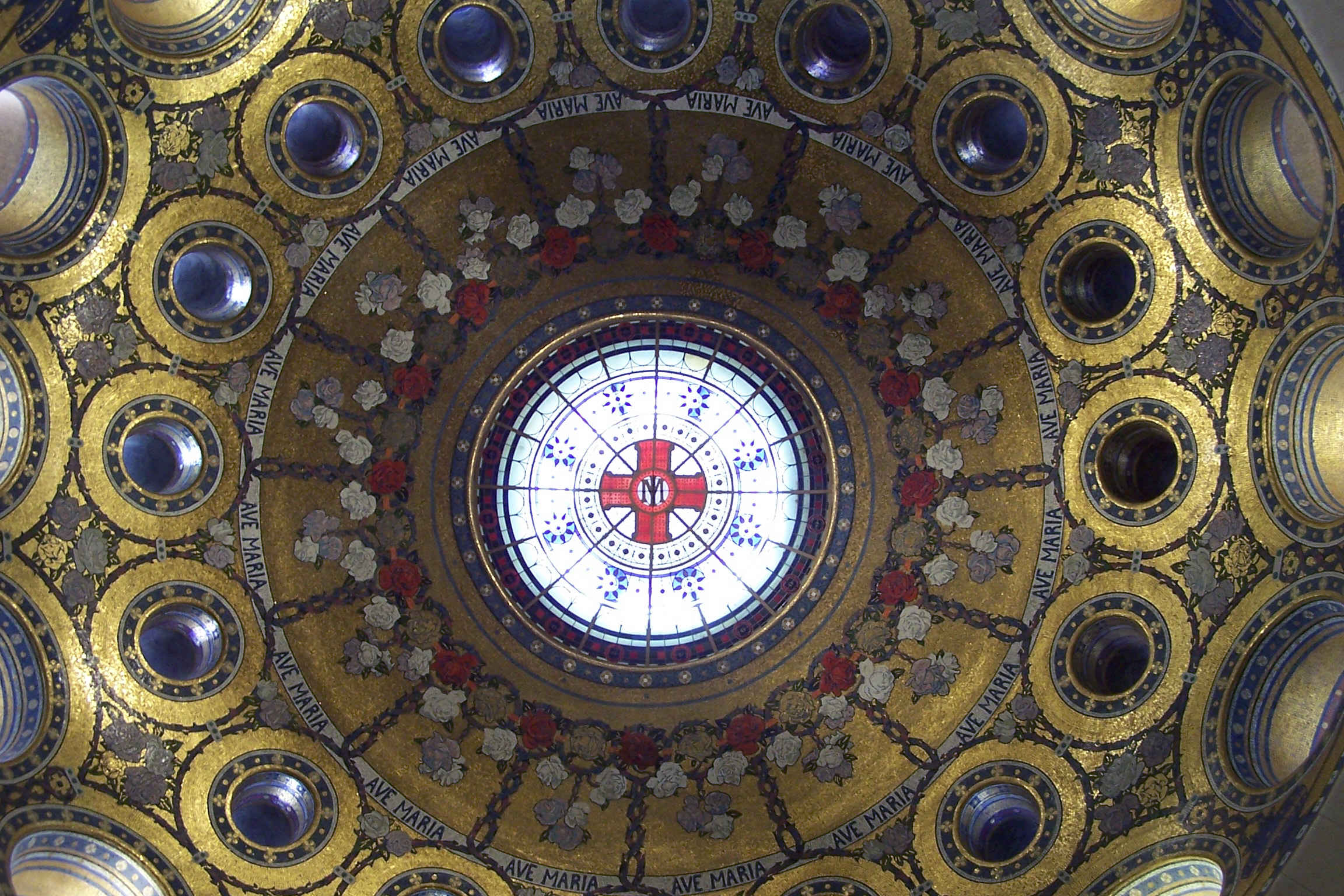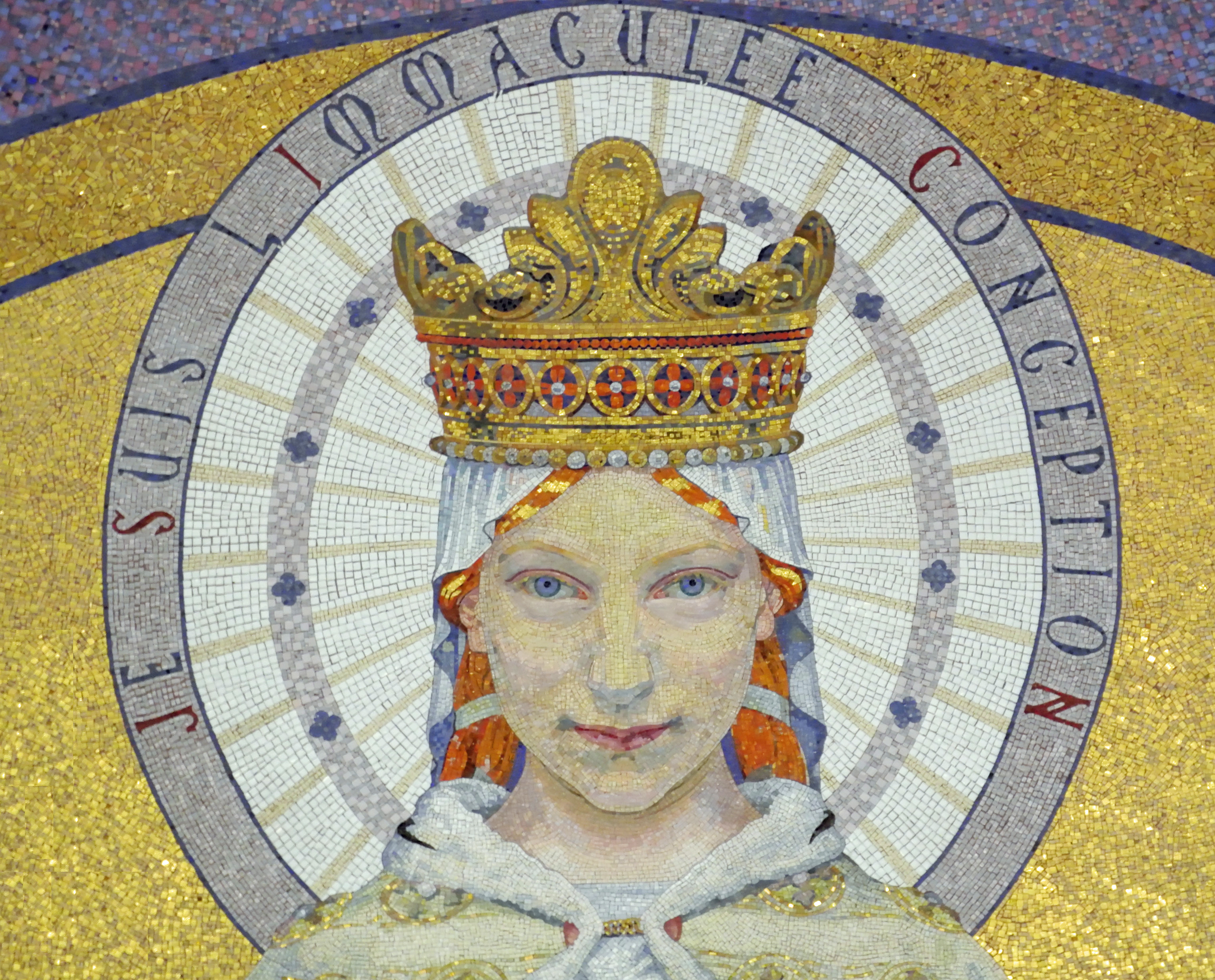Rosary Basilica on:
[Wikipedia]
[Google]
[Amazon]
The Basilica of Our Lady of the Rosary () is a
 The nave is open and circular, surmounted by a dome. The dome contains sixteen circular stained glass windows. The fifteen spaces between these windows signify the fifteen decades of the traditional rosary.
The nave is open and circular, surmounted by a dome. The dome contains sixteen circular stained glass windows. The fifteen spaces between these windows signify the fifteen decades of the traditional rosary.
 The nave is surrounded by fifteen smaller side chapels, one for each of the traditional Mysteries of the
The nave is surrounded by fifteen smaller side chapels, one for each of the traditional Mysteries of the  Most of the mosaics bear a date of around 1900. In each side-chapel is a small altar bearing six candles.
Most of the mosaics bear a date of around 1900. In each side-chapel is a small altar bearing six candles.
 In the upper wall of the sanctuary is a mosaic depicting Mary with outstretched arms and the caption ''Par Marie à Jésus'' ("Through Mary to Jesus").Oliver Todd, ''The Lourdes Pilgrim'', Matthew James Publishing, 2003, p. 44. This depiction, of a very young woman facing directly forwards, is much more in keeping with Bernadette's descriptions of the apparition than the iconic statue in the niche in the Grotto.
In the upper wall of the sanctuary is a mosaic depicting Mary with outstretched arms and the caption ''Par Marie à Jésus'' ("Through Mary to Jesus").Oliver Todd, ''The Lourdes Pilgrim'', Matthew James Publishing, 2003, p. 44. This depiction, of a very young woman facing directly forwards, is much more in keeping with Bernadette's descriptions of the apparition than the iconic statue in the niche in the Grotto.
 The exterior of the dome is surmounted by a dramatic gilded crown and cross, which were a gift from the People of Ireland in 1924. The cross was regilded in 2000-2.
The exterior of the dome is surmounted by a dramatic gilded crown and cross, which were a gift from the People of Ireland in 1924. The cross was regilded in 2000-2.
The official Domain website, which includes maps and webcams
{{Authority control Our Lady of Lourdes Shrines to the Virgin Mary Basilica churches in France Roman Catholic churches completed in 1899 19th-century Roman Catholic church buildings in France Churches in Hautes-Pyrénées Roman Catholic shrines in France
Catholic
The Catholic Church (), also known as the Roman Catholic Church, is the List of Christian denominations by number of members, largest Christian church, with 1.27 to 1.41 billion baptized Catholics Catholic Church by country, worldwid ...
church and minor basilica
Basilicas are Catholic church buildings that have a designation, conferring special privileges, given by the Pope. Basilicas are distinguished for ceremonial purposes from other churches. The building need not be a basilica in the architectura ...
within the Sanctuary of Our Lady of Lourdes in France
France, officially the French Republic, is a country located primarily in Western Europe. Overseas France, Its overseas regions and territories include French Guiana in South America, Saint Pierre and Miquelon in the Atlantic Ocean#North Atlan ...
. Its main theme is a celebration and depiction of the Rosary
The Rosary (; , in the sense of "crown of roses" or "garland of roses"), formally known as the Psalter of Jesus and Mary (Latin: Psalterium Jesu et Mariae), also known as the Dominican Rosary (as distinct from other forms of rosary such as the ...
.
History
The RosaryBasilica
In Ancient Roman architecture, a basilica (Greek Basiliké) was a large public building with multiple functions that was typically built alongside the town's forum. The basilica was in the Latin West equivalent to a stoa in the Greek Eas ...
is the third of the churches to be completed on the site (after the Crypt and the Upper Basilica). It was designed by architect Leopold Hardy and completed in 1899. It was consecrated
Sacred describes something that is dedicated or set apart for the service or worship of a deity; is considered worthy of spiritual respect or devotion; or inspires awe or reverence among believers. The property is often ascribed to objects (a ...
in 1901 and has a capacity of 1,500 worshippers. Its style is influenced by Byzantine architecture
Byzantine architecture is the architecture of the Byzantine Empire, or Eastern Roman Empire, usually dated from 330 AD, when Constantine the Great established a new Roman capital in Byzantium, which became Constantinople, until the Fall of Cons ...
.
In 2006-7 the interior and exterior of the basilica were extensively renovated and the mosaics
A mosaic () is a pattern or image made of small regular or irregular pieces of colored stone, glass or ceramic, held in place by plaster/Mortar (masonry), mortar, and covering a surface. Mosaics are often used as floor and wall decoration, and ...
(many of which were deteriorating) were restored.
Nave
 The nave is open and circular, surmounted by a dome. The dome contains sixteen circular stained glass windows. The fifteen spaces between these windows signify the fifteen decades of the traditional rosary.
The nave is open and circular, surmounted by a dome. The dome contains sixteen circular stained glass windows. The fifteen spaces between these windows signify the fifteen decades of the traditional rosary.
 The nave is surrounded by fifteen smaller side chapels, one for each of the traditional Mysteries of the
The nave is surrounded by fifteen smaller side chapels, one for each of the traditional Mysteries of the Rosary
The Rosary (; , in the sense of "crown of roses" or "garland of roses"), formally known as the Psalter of Jesus and Mary (Latin: Psalterium Jesu et Mariae), also known as the Dominican Rosary (as distinct from other forms of rosary such as the ...
. On the left of the nave are found the Joyful Mysteries; in the centre behind the sanctuary are the Sorrowful Mysteries, and to the right are the Glorious Mysteries.
Each side-chapel comprises a large mosaic with a central image depicting the theme of that Mystery, and an inscription in Latin. Incorporated within the larger image may be smaller images of related themes. For example, the side chapel directly behind the altar contains a depiction of the Crowning with Thorns, which is surmounted by an image of the Ark of the Covenant
The Ark of the Covenant, also known as the Ark of the Testimony or the Ark of God, was a religious storage chest and relic held to be the most sacred object by the Israelites.
Religious tradition describes it as a wooden storage chest decorat ...
(see figure).
 In the upper wall of the sanctuary is a mosaic depicting Mary with outstretched arms and the caption ''Par Marie à Jésus'' ("Through Mary to Jesus").Oliver Todd, ''The Lourdes Pilgrim'', Matthew James Publishing, 2003, p. 44. This depiction, of a very young woman facing directly forwards, is much more in keeping with Bernadette's descriptions of the apparition than the iconic statue in the niche in the Grotto.
In the upper wall of the sanctuary is a mosaic depicting Mary with outstretched arms and the caption ''Par Marie à Jésus'' ("Through Mary to Jesus").Oliver Todd, ''The Lourdes Pilgrim'', Matthew James Publishing, 2003, p. 44. This depiction, of a very young woman facing directly forwards, is much more in keeping with Bernadette's descriptions of the apparition than the iconic statue in the niche in the Grotto.
Façade
The Rosary basilica has a semicircular white marble entry facade, depicting Mary handing the Rosary to St. Dominic. In 1941, the white marble side doors of the basilica were engraved with a message of gratitude to MarshalPhilippe Pétain
Henri Philippe Bénoni Omer Joseph Pétain (; 24 April 1856 – 23 July 1951), better known as Marshal Pétain (, ), was a French marshal who commanded the French Army in World War I and later became the head of the Collaboration with Nazi Ger ...
, who visited Lourdes in 1941 and allowed the Church to reclaim ownership of the Domain. In translation, this inscription read:
The exterior facade of the basilica has been modified in 2007 to include mosaics depicting the Luminous Mysteries, which were added to the traditional fifteen mysteries by Pope John Paul II
Pope John Paul II (born Karol Józef Wojtyła; 18 May 19202 April 2005) was head of the Catholic Church and sovereign of the Vatican City State from 16 October 1978 until Death and funeral of Pope John Paul II, his death in 2005.
In his you ...
in 2002.
See also
* Roman Catholic Marian churches *Our Lady of Lourdes
Our Lady of Lourdes (; ) is one the Marian devotions, devotional names or titles under which the Catholic Church venerates the Mary, mother of Jesus, Virgin Mary. The name commemorates a series of Lourdes apparitions, 18 apparitions reported by ...
* Lourdes apparitions
The Lourdes apparitions are several Marian apparitions reported in 1858 by Bernadette Soubirous, the 14-year-old daughter of a miller, in the town of Lourdes in Southern France.
From 11 February to 16 July 1858, she reported 18 apparitions ...
* Bernadette Soubirous
Bernadette Soubirous, Sisters of Charity of Nevers, SCN (; ; ; 7 January 184416 April 1879), also known as Bernadette of Lourdes (religious name, in religion Sister Marie-Bernarde), was a miller's daughter from Lourdes ( in Occitan), in the Dep ...
References
External links
The official Domain website, which includes maps and webcams
{{Authority control Our Lady of Lourdes Shrines to the Virgin Mary Basilica churches in France Roman Catholic churches completed in 1899 19th-century Roman Catholic church buildings in France Churches in Hautes-Pyrénées Roman Catholic shrines in France